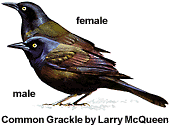Listen to a recording
of a Common Grackle from
the Library of Natural Sounds:
Common Grackles occur throughout the United
States east of the Rocky Mountains; in Canada, these grackles are found north to the
latitude of the Hudson Bay and as far northwest as northeastern British Columbia. They
usually nest in dense colonies with as many as 10 to 30 pairs and occasionally a colony
will have more than 100 pairs. Common Grackles favor conifers close to open areas and
water as nest locations, although a wide variety of sites-from open nests built in clumps
of marsh grass in Red-winged Blackbird colonies to old woodpecker holes and the interior
of barns-have been observed.
Their diet consists of a wide variety of animal and
vegetable food, including insects and invertebrates but also occasional eggs and
nestlings. In rare instances, Common Grackles will attack and eat small birds and lizards,
and in coastal areas they forage at the tide line for small invertebrates, even wading
into the water to capture live fish. During the winter and migration months, their diet
shifts to plant food. Because of their predilection for agricultural grain and seeds,
especially corn, Common Grackles have earned a reputation as a significant pest in certain
areas of North America. These grackles feed in farm fields, pastures, and suburban lawns
by walking, rather than hopping, and they act aggressively toward, even stealing food
from, other ground-foraging birds such as robins. A common display for a male grackle
includes fluffing the body feathers, spreading its wings and tail so as to increase its
apparent size, vocalizing, and posing before a female with its bill held vertical. The
brief, unmusical song is often described as sounding something like a rusty gate. After
the breeding season, Common Grackles form large foraging flocks that often include other
blackbirds and cowbirds. Flock size increases as birds from the northern part of the range
migrate to winter destinations in the southeastern United States, from the Carolinas to
the Gulf Coast. In flight, the flocks tend to be as broad as they are long, unlike the
long and cylindrical flocks of Red-winged Blackbirds.
Description: Common Grackles are large,
iridescent blackbirds (11 to 13.5 inches in length), with pale yellow eyes, a long, sharp
black bill, and long tails. The central feathers of the long, rounded tail are often
depressed, so that the tail is displayed in flight with a deeply keeled V-shape.
Typically, females are about 12 percent smaller than males
and slightly less glossy. Young birds have brown eyes that turn yellow during their first
autumn. Although they may appear to be all black, in good light Common Grackles display a
metallic sheen, the color of which varies regionally. In the southeastern race (the Purple
Grackle) that is found from central Louisiana and Alabama north to southern New York and
Connecticut, the head, back, and sides are purple, the back may show iridescent barring,
and the tail is usually blue green. Birds found west of the Appalachian Mountains and in
New England (the Bronzed Grackle) have blue-green heads, a sharply defined bronze back
without iridescent bars, and a purplish tail. The slightly smaller and nonmigratory
Florida Grackle of peninsular Florida and the Gulf Coast typically has a purple head, dark
green back, and blue-green tail. At one time these races, or subspecies, were separated as
distinct species. Intermediately colored birds may be found where these races meet.
Common Grackles can be distinguished from other similarly
sized all-black blackbirds with yellow eyes, which include the Rusty Blackbird (Euphagus
carolinus) and Brewer's Blackbird (E. cyanocephalus), by their larger size and proportionally longer tails and bills.
Neither Rusty nor Brewer's blackbirds have keeled tails. Common Grackles fly in a
straighter, less undulating manner than other blackbirds. They are much smaller and have
proportionally shorter tails than Boat-tailed and Great-tailed grackles (Quiscalus major and
Q. mexicanus).
Recording
credits:
Common Grackle recording by Arthur A. Allen, LNS catalog number 12664.
Copyright©
1999 Cornell Lab of Ornithology |

|

